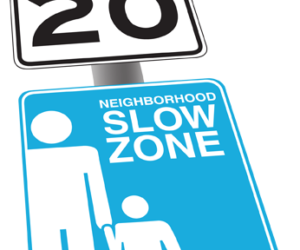 The proposal for a neighborhood slow zone in Park Slope inspired a healthy debate at the Civic Council’s February Board Meeting, and took up a significant part of the evening’s agenda. Discussion started with presentations pro and con about slow zones by Eric McClure and Cathy Sokil Milnikiewicz, respectively. Discussion among the trustees both for and against the Civic Council submitting an application lasted more than an hour.
The proposal for a neighborhood slow zone in Park Slope inspired a healthy debate at the Civic Council’s February Board Meeting, and took up a significant part of the evening’s agenda. Discussion started with presentations pro and con about slow zones by Eric McClure and Cathy Sokil Milnikiewicz, respectively. Discussion among the trustees both for and against the Civic Council submitting an application lasted more than an hour.
Once debate concluded, the vote was taken. Most of the trustees in attendance were in favor of a slow-zone application, which was submitted to the city’s Department of Transportation a few days after the meeting. The application was just the first step in what will likely be a lengthy process of DOT setting up a slow zone in Park Slope. (For more, read “A Step Toward Slow Zones.”)
What follows are the text of the two meeting presentations, discussing both sides of the issue.
Top 10 Reasons Why “20 Is Plenty”
10. Twenty can be beautiful!
We can advocate for better street treatments with New York City Department of Transportation and local elected officials. If you don’t like DOT’s designs for 20-mph zones here, other cities have come up with many other interesting plans.
9. Time is of the essence!
The selection of which neighborhoods receive these zones is an extended, community-intensive process, and we have lots of competition because …
8. Our neighbors are doing it.
Prospect Heights, Boerum Hill, Greenwood Heights, and Windsor Terrace are submitting their own applications.
7. There’s just a minor trade-off in overall driving times.
The 20-mph zone adds just 1.5 minutes to driving time from Flatbush Avenue to Prospect Avenue, and vice versa. It also adds less than 30 seconds to the time from Prospect Park West to Fourth Avenue, and vice versa
6. The arena is coming!
The opening of the Barclays Center in late September is expected to generate several thousand new car trips for each arena event, with many fans driving through Park Slope and searching for free on-street parking.
5. Safer speeds encourage more walking and biking.
- Calmer, quieter streets are more inviting.
- Greater “sense of place.”
- Healthier, happier population.
- Feedback loop: more pedestrians and cyclists encourage safer driving.
4. Safer speeds benefit drivers, too.
- 50% reduction in casualties and serious injuries to vehicle occupants in 20 mph zones.
- Less severe crashes reduce repair costs.
- More people walking and biking means less congestion.
3. Park Slope supports safer speed limits.
- 46 of 47 people who completed surveys after the Jan. 21 public meeting indicated support for safer speed limits.
- Woman-/man-on-the-street reaction to the meeting flyer overwhelmingly favored a 20-mph speed limit.
- At the Park Slope Civic Council’s 2009 Livable Streets brunch, there was a “consensus that lower speed limits would signal the residential nature of our streets and would improve safety for pedestrians, cyclists, and motorists alike.”
- At the Civic Council’s 2006 transportation forum, speeding was the No. 1 concern.
2. Cuts fatalities and serious injuries by half.
- 42% drop in casualties/serious injuries, 50% among kids.
- No “casualty migration” to adjacent areas.
- 27 casualties or serious injuries avoided annually.
- A pedestrian struck by a vehicle traveling at 20 mph is nine times more likely to survive than someone struck by a vehicle traveling at 30 mph.
1. A 20-mph speed limit will make us all safer.
Motor vehicle crashes are the No. 1 cause of death among New York City children.
— Eric McClure is founder of Park Slope Neighbors and a former Civic Council trustee and treasurer.
‘What Matters Is What the People of Park Slope Think’
This is my second year as a Civic Council trustee, and I take the responsibility very seriously. I need to make decisions carefully, and I need to represent the needs and wishes of my community.
I commend the Civic Council’s ad hoc committee that explored local slow zones for its tireless work on the issue. They’ve worked hard in a very condensed period of time. I’m glad the trustees are being given a chance to comment, although I wish the proposal were further along. Nonetheless, we should do our very best to make sure the proposal reflects the interests of the Park Slope community. And we should take our role to educate and inform very seriously.
Community Board 6 District Manager Craig Hammerman, who unfortunately couldn’t be [at the Trustees Meeting], advised the committee very early on in this process about several key facts:
First, any area selected should be small enough that it can represent a microcosm of the larger neighborhood, so that it can be thoroughly documented and studied.
Second, there should be a door-to-door campaign to enlist the affected area’s residents and businesses before submitting a formal proposal. The support of the affected area will count heavily in your favor. If the first time people are hearing about this speed-limit change is after it’s been officially submitted, you’ll be taking an unnecessary and avoidable risk that could endanger any similar type of movements in the future. The last thing you want is for a good idea to suffer backlash simply because people were surprised and didn’t have time to get up-to-speed on the issues.
My concern is that we are at risk of doing precisely what Craig warned us not to do.
I suggested early on to the ad hoc committee that a survey be used primarily to locate individuals and blocks who would be willing to help us with Craig’s grass-roots approach. The committee decided instead to illustrate popular support primarily through the survey administered at the community meeting, the results of which are displayed in the report [handed out at the Trustees Meeting and downloadable here.
As a social scientist, I can tell you that the survey really doesn’t say much.
I’m reminded of a survey by a popular woman’s magazine some time ago. The issue was husbands’ infidelity. According to the survey, close to 80% of husbands were having affairs. But the problem was, women whose husbands had cheated were much more likely to fill out the survey than women who cared less about the subject. A more random sample later concluded that the more accurate figure was about 28%.
I have argued to the committee that this kind of self-selection bias is a serious problem with our data. It is not a random sample.
Moreover, 50 people filled out the survey. Fifty out of 60,000 residents in Park Slope is a very small sample.
Second, even if you accept the data, the survey questions mention nothing of the trade-offs.
For example, according to the DOT website, slow zones are designated primarily via signs, speed bumps, and neckdowns.
What do I think? The signs are ugly. I personally don’t like speed bumps. And neckdowns also tend to be unattractive and take up parking spots — spaces that are precious in Park Slope.
But, frankly, it doesn’t matter what I think. What matters is what the people of Park Slope think, the people we are supposed to be representing.
For example, one woman at the community meeting made a compelling case against speed bumps for many reasons, including damage to the underside of emergency vehicles, discomfort of passengers, and higher emissions. I thought her points made sense, and I wanted to ask for her sources. Instead, her arguments were summarily dismissed. I followed up by speaking to a Midwood Ambulance employee on Seventh Avenue, who confirmed some of the women’s arguments.
I have tried to do my own informal survey. My anecdotal evidence indicates that people are less likely to support slow zones when they are aware of the trade-offs.
For example, a senior at the Y told me, “I want traffic to slow down. Everybody goes too fast.” But when I asked her about speed bumps, her reply was, “I don’t like speed bumps.”
Another, a mother of kids of middle-school to college age, said, “If we lose parking spots, we’re against it.”
Unfortunately, the survey never asks the follow-up question; it makes no mention of these trade-offs.
Slowing down traffic and making streets safer is a no-brainer. No one would disagree. But 20 mph is a drastic reduction. (Whatever happened to 25 mph, anyway?) People complain about drivers going over 30 mph, the current limit, not 25. They are concerned about cars going over 15 mph near schools, and drivers running red lights, talking on cell phones, and making illegal U-turns.
Enforcing current traffic laws should be seriously tried before we start adding signs, speed bumps, and neckdowns. The survey shows people really want enforcement of existing laws. After all, where would we be if drunk-driving laws were not enforced?
If we impose a 20-mph speed limit and insist on greater enforcement, we have to accept that police can and at some point will ticket drivers for going 25.
Be careful what you wish for.
I can’t help feeling we’d be in a very different place right now if early on in this process we had heeded Craig’s advice. Early on, we, the trustees, should have had the opportunity (and with it, the responsibility) to do what I believe the Civic Council was intended to do: educate and inform — indeed, to survey our neighbors, our blocks, the constituencies that each of us represents — to see if a 20-mph speed limit for the whole of Park Slope reflects what residents want.
I know I would be feeling a lot better about the proposal before us. Perhaps there is a way we can still do this, in a Park Slope way with our neighbors clearly supporting us.
— Cathy Sokil Milnikiewicz is a Civic Council trustee, and formerly a professor of Economics at Middlebury College in Vermont and Bard High School Early College in New York City.
from the February 2012 Civic News

